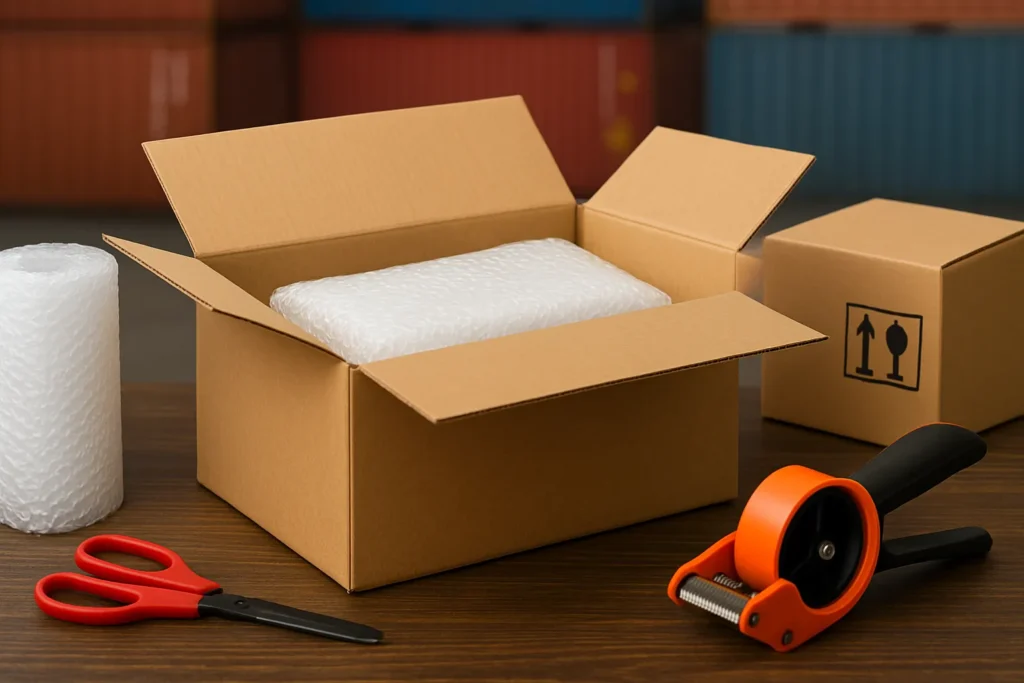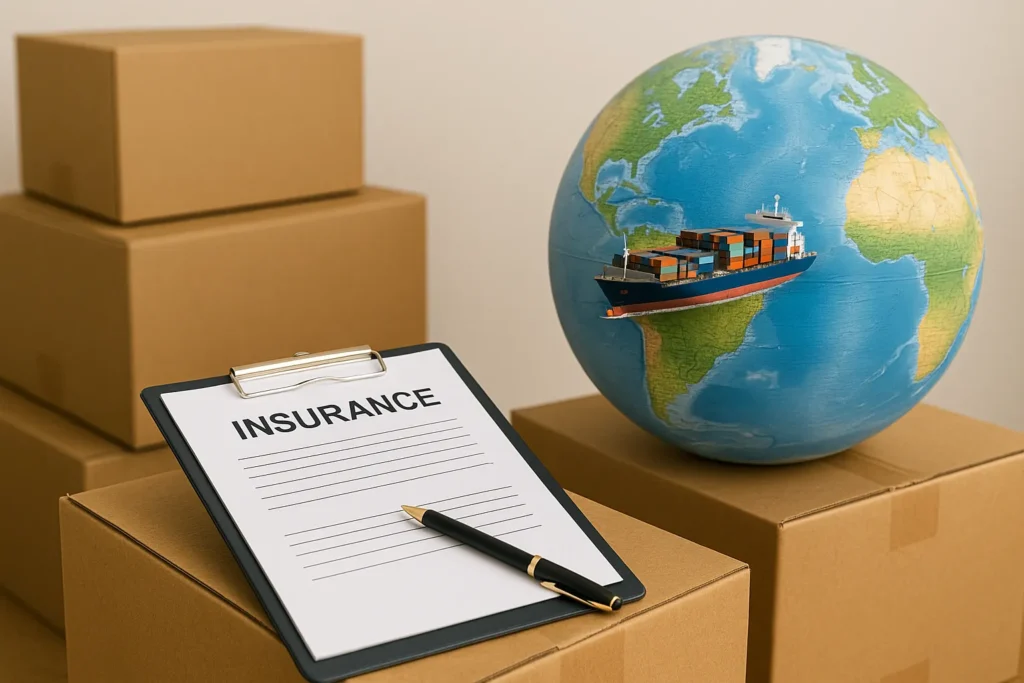Planning an international move is exciting, but few people realise how quickly things can go wrong without proper insurance.
Lost packages and damaged furniture are all too common when shipping items overseas, and every year, countless Australians find this out the hard way.
Fortunately, international moving insurance exists to safeguard your belongings during transit. In this guide, we’ll explain how shipping protection works and share simple, effective tips to help your items arrive safely at your new home.
Let’s start by understanding exactly what this insurance covers.
What Does International Moving Insurance Cover?
If you’re shipping belongings overseas, international moving insurance is one of the smartest protections you can have. This type of insurance covers your possessions while they’re in transit, protecting you from the financial losses that can happen if things go wrong.
Here’s how international moving insurance works:
- It covers your goods during transport across international borders.
- You’re protected against loss, theft, or damage caused by handling or accidents.
- It gives you peace of mind when moving abroad with fragile, expensive, or important items.
Many people are surprised to learn that shipping companies often provide only limited protection. That means if your belongings are damaged or go missing, the compensation might not come close to covering the actual value of your items. It’s one of those details that’s easy to overlook until something happens.
But with proper international moving insurance in place, you’ll have added protection for whatever you’re sending. So if you’re sending personal belongings, furniture, or valuable goods, the right insurance will help you avoid unexpected costs or complications during your move.
But how you pack, label, and organise your shipment can also play a huge role in protecting your belongings. Let’s take a look at a few simple tips to keep your items safe and make sure they arrive in one piece.
Shipping Protection Tips to Help Your Items Arrive Safely

You can avoid many shipping mishaps with the right preparation, but plenty of people overlook simple steps that could protect their belongings. The way you pack and prepare your shipment can directly impact if your items arrive intact.
Let’s break down the ways to protect your shipment and give your belongings the best chance of arriving safely.
Start with the Right Packaging
Everything starts with your choice of boxes. Standard cartons might seem okay, but international shipping means your items will face longer trips, more handling, and plenty of bumps along the way.
Because of this, reinforced boxes or double-walled cartons are a better choice, especially for breakable or valuable items. For heavier shipments or fragile belongings, wooden crates can provide even more protection.
Once you’ve picked strong outer packaging, it’s time to focus on the inside. To keep your items from moving around, use bubble wrap, foam inserts, or packing paper.
We recommend wrapping fragile items individually and filling any empty spots in the box to add extra cushioning. This extra care will protect your belongings from bumps and impacts during shipping.
Double-Check Your Labels
Incorrect or unclear labels are often the reason shipments go missing or get delayed. So take a few extra minutes to double-check every detail.
Start by including the full recipient address, country codes, and contact numbers. Also, place a second copy of the shipping details inside the box in case the outer label gets damaged during transit.
Choose a Reliable Shipping Company
Not all shipping providers offer the same level of service or protection. We recommend going for a reputable company that specialises in international moves. They often provide tracking, packaging advice, and clear insurance options so you know that your shipment is covered.
You’ve now got the right packing, labelling, and shipping company covered. Your belongings are far more likely to arrive intact. Still, there’s more to think about when it comes to keeping them fully protected.
Now’s a good time to see what international moving insurance covers and what parts of the fine print you don’t want to miss.
What’s Covered by International Moving Insurance (And What’s Not)

International moving insurance typically covers loss, theft, and damage to your belongings during transit. But like any policy, there can be fine print. If you know what’s covered, what’s excluded, and where people often get caught out, you can avoid a lot of unnecessary stress.
Here’s what you need to know before trusting your shipment to a carrier.
What’s Typically Covered
Most reputable international moving insurance policies will cover:
- Household goods like furniture, appliances, and everyday belongings
- Electronics, including TVs, computers, and gaming consoles
- Fragile or high-value items such as artwork, antiques, glassware, or musical instruments
But there’s a catch. For fragile or expensive items, insurers often require professional packing. That means something like a mirror wrapped in bubble wrap at home might not be covered. But if the same item is packed in a reinforced crate with proper cushioning by a professional, it usually meets the policy requirements.
Also, keep in mind that some policies only cover items based on their declared value, not the full replacement cost. That’s why getting your valuations right from the start is really important.
What’s Commonly Excluded
Insurance won’t cover everything. You’ll often see exclusions for:
- Poorly packed or self-packed items that don’t meet professional standards
- Misdeclared goods or incorrect valuations
- High-value items like jewellery, cash, or rare collectibles without extra declarations
- Damage from war, political unrest, or natural disasters at the destination
For example, if you ship expensive artwork without proper packaging or paperwork, your insurer may deny the claim, even with coverage in place.
Why You Must Read the Product Disclosure Statement (PDS)
The PDS spells out your coverage, exclusions, and conditions in plain terms. It’s your responsibility to review this carefully before shipping your belongings. This document also tells you how claims get handled and what proof you’ll need if something goes wrong.
Watch for Grey Areas
Keep in mind that some situations aren’t always straightforward. Things like partial damage, lost items, or theft during transit can be tricky, and insurers might only cover part of the claim if packaging or labelling wasn’t done properly.
You can avoid such costly mistakes by learning the details upfront. Next, we’ll show you how to compare insurance options and pick the right protection for your move.
How to Pick the Right Insurance for Moving Overseas

You might think choosing international moving insurance is simple, but it’s more complicated than it looks. Why? It’s because not all policies offer the same protection, and cutting corners can leave you exposed to costly surprises.
You want to look for the following to make sure your belongings are properly covered.
Understand the Types of Coverage
First, you should know that there are usually three main options:
- Full Replacement Value: You’ll be compensated for the actual cost to replace your lost or damaged items, based on today’s market rates.
- Declared Value: Covers the amount you state your shipment is worth, so underestimating this can limit your payout.
- Partial Loss or Damage: Protection applies to specific parts of your shipment if only some items are affected.
For example, if your shipment includes electronics, artwork, or custom furniture, choosing full replacement coverage is often the safer option. It might cost a bit more in premiums, but it’s worth the extra peace of mind.
Compare Costs with Potential Risks
Now, let’s take a look at some potential risks. Think about the value of your belongings, how far they’re travelling, and the type of transport (air, sea, or land) to find the right balance.
You also need to think about the risk factors in your destination country, such as rough handling, political unrest, or unpredictable weather. If you’re sending fragile items or shipping to high-risk places, paying a little extra for better coverage can save you money, hassle, and stress later on.
Check the Reputation of Providers
Now that you’re aware of the risks, it’s just as important to make sure you’re working with the right providers. Experienced logistics companies often work with trusted insurers.
To find the best option, look for providers with a strong track record in international moves, good reviews for handling claims, and clear advice on packaging to help prevent issues.
Ask the Right Questions Before You Buy
We recommend confirming the important details by asking your provider these few questions:
- Does this policy cover your specific destination and transport method?
- What’s the claims process and typical response time?
- Are there exclusions based on packaging or item type?
Once you’ve got those answers, you’ll be in a much better position to make informed decisions. To help you stay organised, let’s run through a simple checklist that covers the key steps for safe, insured shipping.
Your Quick Checklist for Safe and Insured International Shipping
Getting your belongings to your new home safely often comes down to good planning. Just a few easy steps can greatly improve the chances of protecting your shipment and avoiding costly mistakes.
Before you send anything overseas, run through this quick checklist:
- Choose a reputable shipping company that offers reliable insurance options.
- Use the right packaging materials like bubble wrap, reinforced boxes, and secure seals.
- Label every shipment clearly with the correct recipient’s address and contact details.
- Take the time to read and understand the Product Disclosure Statement so you know exactly what your insurance covers.
- Double-check that your coverage suits your needs before you leave Australia.
Your shipment gets the best chance of arriving intact with these steps. After this, you should be ready to move abroad knowing both your items and your investment are covered.
Why Shipping Insurance Should Be Part of Your Moving Plan
International shipping always involves some risk, but smart preparation and the right protection can greatly reduce potential losses. If you’re moving your household overseas or sending goods for your business, start by getting to know your insurance options.
Choosing trusted shipping providers, like Homeport Northwest, and carefully reviewing your insurance documents are your next steps. Make sure you are clear on what your policy covers, how the claims process works, and what packaging standards are required to keep your cover valid.
Good preparation will protect your belongings and ensure any issues are resolved quickly if something goes wrong. And with moving insurance, you’re getting peace of mind along with smart protection for your belongings and finances. So why wait?
